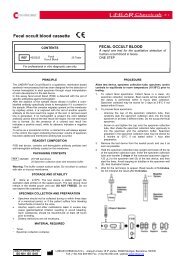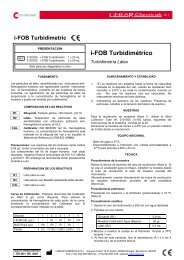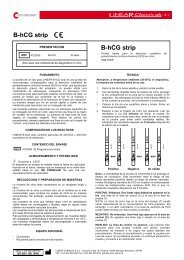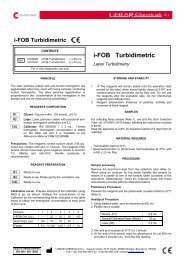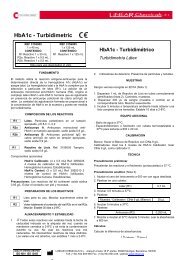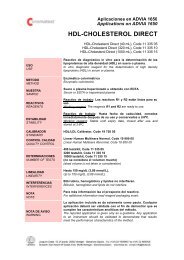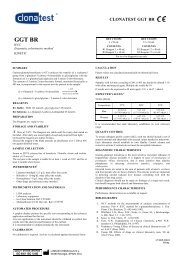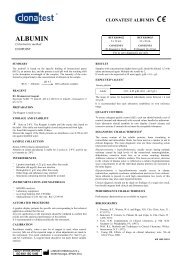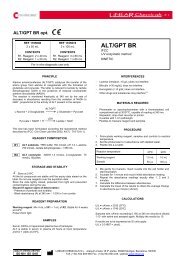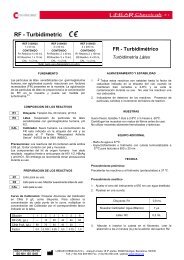Antitrombina III id ANTITROMBINA III - Linear
Antitrombina III id ANTITROMBINA III - Linear
Antitrombina III id ANTITROMBINA III - Linear
You also want an ePaper? Increase the reach of your titles
YUMPU automatically turns print PDFs into web optimized ePapers that Google loves.
<strong>Antitrombina</strong> <strong>III</strong> <strong>id</strong>REF3307005PRESENTACIÓN<strong>Antitrombina</strong> <strong>III</strong>1 x 15 tests<strong>ANTITROMBINA</strong> <strong>III</strong>Determinación cuantitativa de antitrombina <strong>III</strong> porinmunodifusión radialSólo para uso diagnóstico in vitroFUNDAMENTOLa proteina a analizar, al difundir en gel de agarosa en el que se ha disueltoel anticuerpo específico, forma un inmunocomplejo visible como un anilloalrededor del pocillo de siembra. El diámetro de este anillo es proporcional ala concentración de la proteina analizada.Esta proporcional<strong>id</strong>ad esta en función del tiempo de migración. De hechocuando la migración ha terminado (72 horas), el cuadrado del diámetro eslinealmente proporcional a la concentración (Procedimiento 1). Mientras quepara tiempos inferiores, el cuadrado del diámetro es logaritmicamenteproporcional a la concentración (Procedimiento 2). En estos dos casos, esnecesario construir una curva de calibración utilizando al menos tres puntosde calibración.Junto a la placa, se adjunta una tabla de correlación en la que a cadadiámetro del proceso de difusión terminado, viene asociada unaconcentración (Procedimiento 3).COMPOSICION DE LOS REACTIVOSPlaca de gel de agarosa que contiene el antisuero específico frente a laproteina a analizar.ALMACENAMIENTO Y ESTABILIDADConservar a 2-8ºC.Las placas estan listas para su uso.Los Reactivos son estables hasta la fecha de caduc<strong>id</strong>ad indicada en laetiqueta.MUESTRASSuero ó plasma. Estabil<strong>id</strong>ad 6 días a 2-8 ºC.PROCEDIMIENTO ANALITICOAtemperar la placa a temperatura ambiente, abrirla y esperar que la posiblecondensación presente en los pocillos de siembra se evapore.Pipetear 5 µL de muestra y/o controles y esperar la completa reabsorción delos mismos. Cerrar la placa y colocarla en una cámara húmeda durante eltiempo necesario para el desarrollo del análisis:- 72 horas para el Procedimiento 1 ó 3.- 18 horas para el Procedimiento 2.INTERPRETACION DE RESULTADOSMedir el anillo de precipitación, con un sistema que asegure un errormáximo de 0.1 mm, al tiempo establec<strong>id</strong>o de acuerdo al procedimientoaplicado, 72 horas para los Procedimientos 1 y 3, 18 horas para elProcedimiento 2.Procedimiento 1Colocar en un papel milimetrado, el cuadrado de los anillos de precipitacióny la concentración de los controles utilizados. Se debe obtener una recta conuna intercepción comprend<strong>id</strong>a entre 10-12 mm. Los valores de las muestrasse obtienen por interpolación.Procedimiento 2Colocar en papel milimetrado, el cuadrado de los anillos de precipitaciónfrente al logaritmo de la concentración de los controles utilizados. Se debeobtener una curva que es practicamente una recta para los valores bajosmientras que para los valores altos se curva ligeramente. Los valores de lasmuestras se obtienen por interpolación.Procedimiento 3Leer sobre la tabla que se adjunta, los valores de concentración en funcióndel diámetro del anillo de precipitación. El suero de control, de utilizarse deacuerdo a este procedimiento, deberá dar un anillo de precipitación quedifiera como máximo 0.2 mm del valor inclu<strong>id</strong>o en la tabla.OBSERVACIONESEl tiempo de difusión y por tanto el tiempo de lectura depende de laconcentración y del tipo de proteina analizada. Después de 72 horas, ladifusión de cualquier proteina a cualquier concentración habrá finalizado.Para concentraciones no elevadas, es posible leer a tiempos notablementeinferiores (36 horas) aunque, en estos casos, es aconsejable realizar unanueva lectura después de 3-5 horas y comprobar que el diámetro del anillode precipitación no ha variado y segu<strong>id</strong>amente calcular la concentración. Sise ha produc<strong>id</strong>o una variación, repetir la lectura después de otras 3-5 horas.CONTROL DE CALIDADPara un control de cal<strong>id</strong>ad adecuado se sugiere utilizar un control interno queno va inclu<strong>id</strong>o en el kit.CARACTERISTICAS ANALITICAS- Límites de med<strong>id</strong>a. 7-80 mg/dL.- Precisiónmg/dL Intraserial InterserialMedia 35,61 67,8 35,5 67,95DE 0,54 0,63 0,44 0,68CV% 1,52 0,93 1,26 1,01N 10 10 20 20Replicados: 10 por nivel.Replicados: 20 por nivel- Correlación. Este ensayo (x) fue comparado con un métodocomercial similar (y). Los resultados fueron los siguientes:N = 70 r = 0,9992 y = 0,98x + 0,77<strong>Antitrombina</strong> <strong>III</strong>VALORES DE REFERENCIA20-40 mg/dLREFERENCIASFahey et al., J. Immunol., 94: 84 (1965)Mancini et al., Immunochemistry, 2: 235 (1965)QUALITY SYSTEM CERTIFIEDISO 9001 ISO 13485LINEAR CHEMICALS S.L. Joaquim Costa 18 2ª planta. 08390 Montgat, Barcelona, SPAINTelf. (+34) 934 694 990 Fax. (+34) 934 693 435. website www.linear.es
Antithrombin <strong>III</strong> <strong>id</strong>REF3307005CONTENTSAntithrombin <strong>III</strong>1 x 15 testsANTITHROMBIN <strong>III</strong>Quantitative determination of Antithrombin <strong>III</strong> by radialimmunodiffusionFor in vitro diagnostic use onlyRI33008-1/0404R1.PRINCIPLEThe examined protein, diffusing in agarose gel containing a specific antibodywill form an immuno-complex, visible as a ring around the well. The ringdiameter is in proportion to the concentration of the analyzed protein. Theproportion corresponds to the diffusion time. In fact, at the end (72 h), thesquare of the diameter will be in linear proportion to the concentration(Procedure 1), while after a shorter period of time the square of the diameterwill be in a logarithmic proportion to the concentration (Procedure 2). In bothcases, a calibration curve should be constructed, using at least threecalibration points. However, a reference table is prov<strong>id</strong>ed showing therelation between any concentration and the diameter at the end of theanalysis time.REAGENT COMPOSITIONPlate with agarose gel containing the antiserum for the specific protein to beanalyzed.STORAGE AND STABILITYStore at 2-8ºC.The plates are ready to be used.The Reagents are stable until the expiry date stated on the label.SAMPLESSerum or plasma. Stable six days at 2-8 ºC.ASSAY PROCEDUREAllow the plate to come to room temperature, open it and, if moisture ispresent on the wells, wait until it has evaporated. Withdraw 5 µL of samplesand/or controls and wait until it has been completely absorbed beforehandling the plate. Cover it tightly and place it in a moist chamber during theincubation time:- 72 hours for the Procedure 1 or 3.- 18 hours for the Procedure 2.READING TEST RESULTSMeasure the precipitation ring to the nearest 0.1 mm, after the requiredperiod according to used assay procedure, 72 h for Procedure 1 or 3, 18 hfor Procedure 2.Procedure 3Read on the enclosed Reference Table, the concentration valuecorresponding to the precipitation ring diameter. The ring value obtained forthe control should have a conf<strong>id</strong>ence limit of 0.2 mm (from the referencetable).NOTESThe diffusion time and the reading time depend on the concentration and thespecific diffusing protein. After 72 hours, the diffusion of the protein, at anyconcentration, is completed. For lower concentrations, it is possible to read atlower times (ie 36 h). However, in such cases it is advisable to read againafter 3-5 hours. If the diameter is still the same, it is possible to set theconcentration, on the contrary, if the diameter is different, the ring should beremeasured after a further 3-5 hours.QUALITY CONTROLIt is suggested to perform an internal quality control. Not included in the kit.ANALYTICAL PERFORMANCE- Measure´s limit. 7-80 mg/dL.- Precisionmg/dL Intra-assay Inter-assayMean 35.61 67.8 35.5 67.95SD 0.54 0.63 0.44 0.68CV% 1.52 0.93 1.26 1.01N 10 10 20 20Replicates: 10 for each level.Replicates: 20 for each level.- Correlation. This assay (x) was compared with a similar comercialmethod (y). The results were:N = 70 r = 0.9992 y = 0.98x + 0.77REFERENCE VALUESProcedure 1Reproduce on a plotting paper, the square of the precipitation rings and theconcentration of the controls. A line with an intercept should be in the range10-12 mm 2 . Sample values are determined by interpolation.Procedure 2Reproduce on a plotting paper, the square of the precipitation rings againsttheir concentration logarithms. The graph will be a straight line only for a lowvalues. For high values may curve a little. Sample values are obtained byinterpolation.Antithrombin <strong>III</strong>20-40 mg/dLREFERENCESFahey et al., J. Immunol., 94: 84 (1965)Mancini et al., Immunochemistry, 2: 235 (1965)RI33070-1/0404R1.QUALITY SYSTEM CERTIFIEDISO 9001 ISO 13485LINEAR CHEMICALS S.L. Joaquim Costa 18 2ª planta. 08390 Montgat, Barcelona, SPAINTelf. (+34) 934 694 990 Fax. (+34) 934 693 435. website www.linear.es



